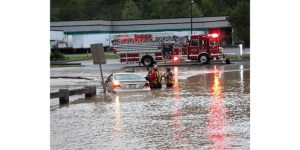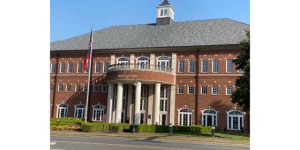The Town Crier: Thanksgiving 1941
Published 8:00 am Thursday, November 28, 2024
There is an old hymn we sang in the church I grew up in called “Count Your Blessings.” In the song we are enthusiastically asked to count our blessings and name them one by one.
There have been times in my life where I’m confronted with something that seems a pretty tall order and it’s got me down. This song will pop in my head and when I indeed start naming all the good things in my life, the challenges seem, not just outnumbered, but surrounded as well.
Trending
At this time in our history things are pretty good, despite what the news tells us. Especially if we live in a small town in a quiet part of the country. It was while ruminating on this that I thought about the Dalton area back just before World War II, and specifically, Thanksgiving of 1941, just a couple of short weeks before the nation would be plunged into the World Wide War with the sneak attack bombing of Pearl Harbor on Dec. 7 of that year.
What must it have been like in a small mill town in the depressed (as in the Great Depression) South when no one could know how drastically things were about to change. With the entry into the war, families would be torn apart, in some cases, never to be reunited in this lifetime. For others, it would, in retrospect, be a turning point in their lives as well, as the war years gave them opportunities both good and bad that would impact them decisively. So here’s a look at that last Thanksgiving of peace and quiet, before America, and specifically Dalton, entered a world aflame.
Keeping the work going
In 1941 for more than 10 years, since the late 1920s, the U.S. and the world had been going through the Great Depression. There had been some improvements in the mid-’30s in the situation but in the late ’30s things had taken another dip. It was so bad here in the early ’30s that the hospital had to be shut down for about a year due to a lack of funding. The doors were closed and only a single caretaker was kept on to keep the hospital in shape until they could reopen it.
As bad as things got here, they were still better than many parts of the country. We didn’t have a Dust Bowl here where folks had to migrate west looking for work. We didn’t have the long bread and soup lines that some of the big cities like New York and Detroit had when industry slowed to a trickle. In the pre-carpet years, most of the mills kept going (people still needed cotton even if the prices had dropped), and some of the other industries like the Manly Jail Works, numerous bedspread makers, wood mills and cotton gins kept the work going.
I discovered a map of Dalton from February 1941 on the internet. It’s an “insurance” map that they used to do for fire safety. The maps were like yesterday’s Google street views, as it showed all the buildings and had a lot of information about the locale.
Trending
For example, the maps gave information on what was in the buildings (i.e., cotton warehouse), if a night guard was on duty, how the building was heated (steam via coal boiler) and if there were city water pipes to the building, pails with water or sand, or fire extinguishers for chemical fires handy.
Some structural details were given as well, such as if the building was “fireproof,” generally meaning it was built out of brick. It was also noted if there were second floors and if the pillars were wooden in the structure. With these kinds of details we can get a good picture of what Dalton was like at the time of the entry into World War II, and from that imagine what the daily life was like.
Large businesses
One of the things that jumps out at you from looking at the map is that at the time there were numerous large businesses in the Dalton area. Mostly arranged with access to the railroad were several large mills like the Boylsten Cotton Mill and Crown Cotton Mill. There was a large operation called the Duane Chair Manufacturing Co., and numerous lumber mills/yards to support those businesses.
There were several “steam cleaners” that I believe had to do with the chenille/bedspread businesses that also dotted the map. The bedspread mills included the G.H. Rauschenberg Co., Ken-Rau, Log Cabin and Cherokee Bedspreads, which were all large operations, and then smaller companies like Evans, Gordo, Novelty, La Rose and Blue Ridge. There are even small buildings behind houses in town that are listed as bedspread makers but are so small that they aren’t even given a company name but just marked by what was made inside. Many of these bedspread makers, and certainly the workers that made a living in those businesses, would move into the carpet industry 15 or 20 years later when carpet hit big.
Home to homes
Another thing that jumps out from the maps if one is familiar with todays’ Dalton is the number of houses in town. The streets “downtown” that are now filled with businesses were then the home to homes. Downtown Dalton was a bit of business, with family houses all around. For example, from the map there appears to have been a rather grand house where the Cremo Drive-in is now. Leading up to 1941 it must have been great to have been a kid and able to walk to the neighbors or other friends a block or so away. That scene was recreated in the years after the wars, especially beginning in the 1960s and ’70s when the suburb areas grew, places like Brookwood and Westerly Heights.
But whereas the later iterations of the “neighborhood” were great for house to house roaming, the kids who lived then could have just as easily walked over to various businesses as well. They could go watch the new cars being unloaded at the car dealerships, ride their bikes down to one of the many little restaurants that seem to have been part of each filling station back them, and something I’ve heard from my grandfathers, there was great pleasure back then in going down to the railroad tracks, which would have just been a hop, skip and a jump from their house, and watch those amazing steam trains work, whether they were an express speeding through town going to some exciting place like a big city or the oceanside, or a local engine working the switchyard to put the boxcars carrying bedspreads, furniture or pre-fab jail cells together to make up a train.
Entertainment options
For entertainment in those days we can see from the map that there were two movie theaters, the Crescent and the Shadowland, which was in the process of being torn down and rebuilt as the much larger movie palace The Wink Theatre.
There was a city swimming pool at the time, on the north end of town, near where First Baptist Church is now. It would have been closed for the winter, but memories of swimming there in the summer were still fresh.
There were generally no TVs in 1941, but there was radio, and Dalton was home to WBLJ, which first broadcast on April 8, 1940. According to the map, the broadcast studio at that time was upstairs over a funeral home downtown. For readers, there were newsstands, and the public library was in the old Robert Loveman house on the southwest corner of Waugh and Thornton.
‘Over there’ wars
In November 1941 war had been going on in Asia and Europe for years. Japan had started conquering China in 1931 with its invasion of Manchuria. Then, Hitler’s expansion of Germany in the mid-1930s up to the invasion of Poland in 1939 had things roiling in Europe.
For Americans, these were “over there” wars, with great oceans to protect us from the fighting going on. The parents were probably paying attention, but only a handful of folks thought we’d be dragged into another war in Europe or Asia after World War I.
It was fall and the Dalton High football team had been playing with the town turning out to cheer them on. Armistice Day (our current Veterans Day) would have been on Nov. 11, and then, toward the end of the month was Thanksgiving Day. The weather would have been similar to this year’s and the leaves changing would be just as beautiful. The papers would soon be full of Christmas sale ads as well as ongoing listings of community activities such as special singings of Christmas carols at churches in the area. In other words … it was the quiet before the storm.
Truiy grateful
For Thanksgiving 1941, families and friends were going to gather for a meal and give thanks for all their blessings. They would enjoy each other’s company and share memories and family stories as they made new ones. And to think there were teens running around in the fall of 1941 with no idea that in the coming years they would be shipping out to battlefields around the world.
This Thanksgiving, let’s count each of our blessings one by one, and make sure we’re truly grateful for all the good in our lives.
Mark Hannah, a Dalton native, works in video and film production.





